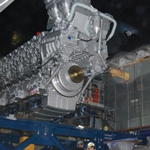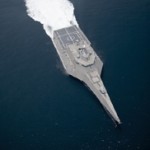Fuel Efficient Three-Engine Layout On Next Generation Trimaran
 Austal‘s next generation 102-metre high speed trimaran – scheduled for completion by February 2010 and available for purchase – has had its unique three-engine layout successfully installed ahead of the vessel’s launch next month . The patented three engine layout combines with the trimaran’s hydrodynamic hull form to deliver fuel efficiency across a range of operating conditions.
Austal‘s next generation 102-metre high speed trimaran – scheduled for completion by February 2010 and available for purchase – has had its unique three-engine layout successfully installed ahead of the vessel’s launch next month . The patented three engine layout combines with the trimaran’s hydrodynamic hull form to deliver fuel efficiency across a range of operating conditions.
Each of the three MTU 20V 8000 M71L diesel engines produce 9,100 kW at less than 1,200 rpm and offer the world’s highest power-to-weight ratio in their power range. Head of Austal Design, Dr Tony Armstrong, said the three-engine arrangement, along with Austal’s trimaran technology, presented a number of significant benefits to operators. “A three-engine layout saves weight over the traditional four-engine layout, delivering improvements to fuel consumption and daily running costs,” Dr Armstrong said. “Compared to other high speed craft with the same installed power, Austal’s next generation trimaran allows greater speed, and achieves lower fuel consumption when operating at the same speeds,” he said.
 Austal’s latest trimaran ferry builds on the company’s landmark trimaran Benchijigua Express, delivered to Spanish operator Fred Olsen S.A. in 2005. Since delivery, Benchijigua Express has demonstrated the benefits of Austal’s trimaran technology in commercial operation. “Along with superior passenger comfort when operating in the same sea conditions, the trimaran hull form can operate at a higher wave height while maintaining a higher speed in waves. The extent of waves created behind the vessel is also reduced which may impact on the environment,” Dr Armstrong said. Others to recognise the unique benefits of Austal’s trimaran technology include the United States Navy, for which Austal is currently building two 127-metre trimaran Littoral Combat Ships. Austal’s new 102-metre trimaran has a maximum deadweight of 700 tonnes, a speed of up to 39 knots and the capacity for 1165 passengers and 245 cars.
Austal’s latest trimaran ferry builds on the company’s landmark trimaran Benchijigua Express, delivered to Spanish operator Fred Olsen S.A. in 2005. Since delivery, Benchijigua Express has demonstrated the benefits of Austal’s trimaran technology in commercial operation. “Along with superior passenger comfort when operating in the same sea conditions, the trimaran hull form can operate at a higher wave height while maintaining a higher speed in waves. The extent of waves created behind the vessel is also reduced which may impact on the environment,” Dr Armstrong said. Others to recognise the unique benefits of Austal’s trimaran technology include the United States Navy, for which Austal is currently building two 127-metre trimaran Littoral Combat Ships. Austal’s new 102-metre trimaran has a maximum deadweight of 700 tonnes, a speed of up to 39 knots and the capacity for 1165 passengers and 245 cars.






